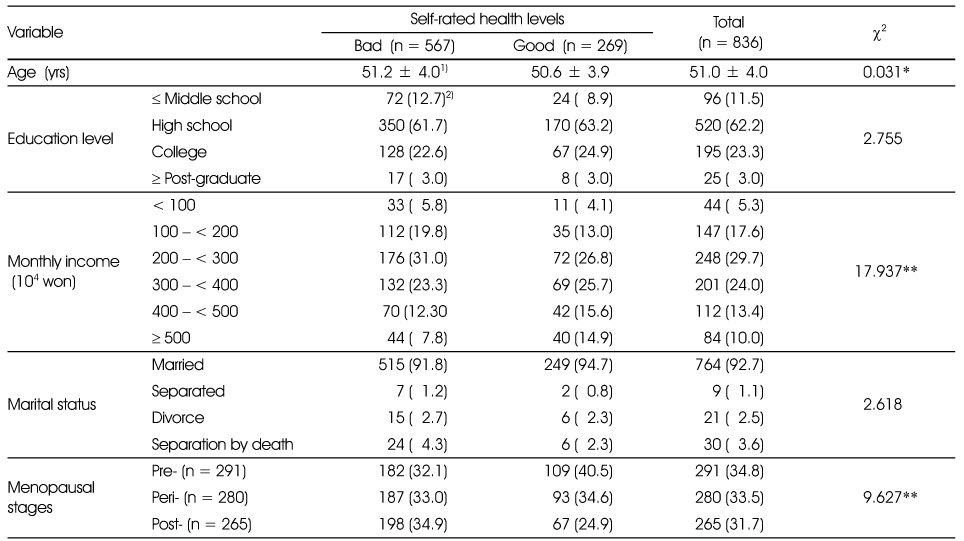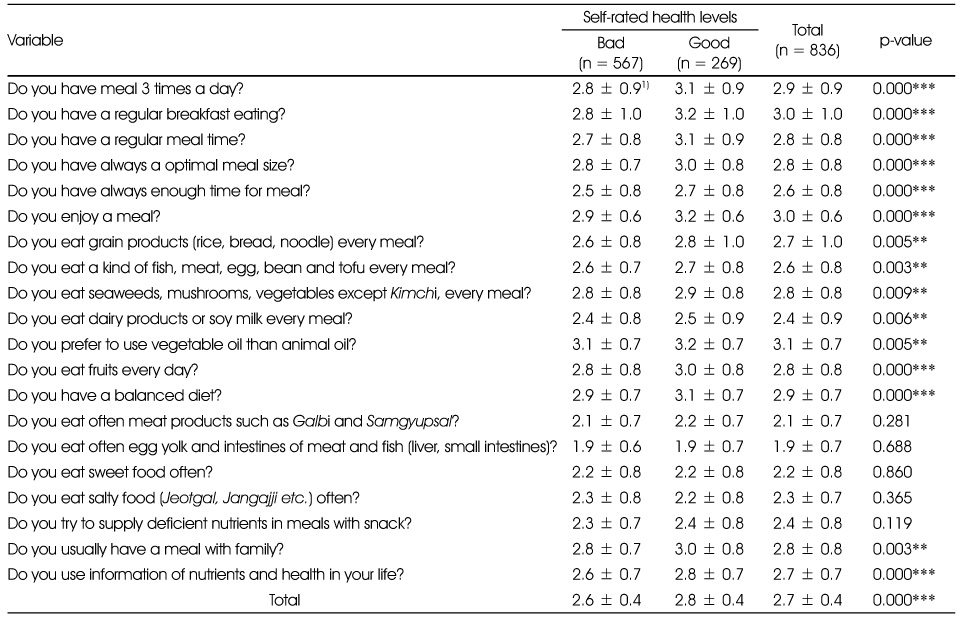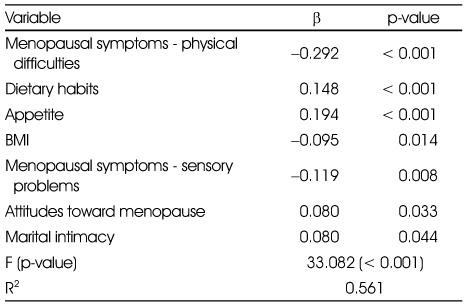References
1. American Dietetic Association. Position of the American dietetic association: food fortification and dietary supplements. J Am Diet Assoc 2001. 101(1)115–125.
2. Appels A, Bosma H, Grabauskas V, Gostautas A, Strumans F. Self-rated health and mortality in a Lithuanian and Dutch population. Soc Sci Med 1996. 42681–689.
3. Baek SS. An analysis of the relationship of menopausal symptoms of midwife women between urban area. J Korean Acad Womens Health Nurs 1998. 4(3)332–347.
4. Bailis DS, Segall A, Chipperfield JG. Two views of self-rated general health status. Soc Sci Med 2003. 56203–217.
5. Bowling A. Measuring Disease 2001. 2nd editionth ed. Buckingham · Philadelphia: Open University; 2–8.
6. Chang HK, Han YB. A study on the climacteric symptoms and dietary patterns in middle-aged women. J Korean Home Econ Assoc 2002. 40(1)125–134.
7. Choi IR. Anger expression type and mental health in middle aged women. J Korean Acad Nurs 2009. 39(4)602–612.
8. Feeny D, Torrance GW, Furlong W, Goldsmith C. Health utilities index mark 3: utility scores for 74 prevalent health states. Quality Life Res 1995. 4(5)424.
9. Fylkesnes K, Forde OH. The tromoso study; predictors of self-evaluated health-Has society adopted the expanded health concept? Soc Sci Med 1991. 32(2)141–146.
10. Gander J, Lee D, Sui X, Hbert JR, Hooker SP. Self-rated health status and cardiorespiratory fitness as predictors of mortality in men. Br J Sports Med 2011. 45(14)1095–1100.
11. Goodwin DK, Knol LL, Eddy JM, Fitzhugh EC, Kendrick OW, Donahue RE. The relationship between self-rated health status and the overall quality of dietary intake of US adolescents. J Am Diet Assoc 2006. 1061450–1453.
12. Grant MD, Piotrowski ZH, Chappell R. Self-related health and survival in the logitudinal study of aging, 1984-1986. J Clin Epidemiol 1995. 48(3)375–387.
13. Hilditch JR, Lewis J, Peter A, van Maris B, Ross A, Franssend E, Guyatt GH, Norton PG, Dunn E. A menopause-specific quality of life questionnaire: Development and psychometric properties. Maturitas 1996. 24(3)161–175.
14. Idler EL, Benyamini Y. Self-rated health and mortality - A review of twenty-seven community studies. J Health Soc Behav 1997. 3821–37.
15. Kim AK. Yangsaeng and health related quality of life (HRQOL) in middle aged women. Korean J Women Health Nurs 2010. 16(3)297–306.
16. Kim HC, Kim MR. A study on health-functional foods intake pattern of consumers in Busan and Gyeongnam area. Korean J Hum Ecol 2006. 15(2)341–352.
17. Kim HJ. Comparison of the level of marital intimacy according to the level of stress among middle-aged women. J Korean Soc Matern Child Health 2001. 5(1)123–136.
18. Kim HS, Yoon KH, Lee MJ, Seo BH. Intake and awareness of the functional health food among housewives in Cheongju area. J Hum Ecol 2005. 9(2)179–196.
19. Kim MY, Han SY, Jeong JH, Kim SH, Lee JK, Park ES, Zhang XH, Seo JS. Effectiveness of nutrition-exercise education program on weight control of adult women. Korean J Community Nutr 2009. 14(2)168–174.
20. Koo NS, Park JY. Health states and health-related lifestyle of middle-aged people in Daejon. Korean J Diet Cult 2001. 16(2)137–146.
21. Kwak EK. The middle life women's menopause knowledge, attitude, symptom and management 2006. Graduate School of KonKuk University; 7–16.
MS thesis.
22. Lee JY. A study on wives' marital satisfaction and related variables. J Korean Home Econ Assoc 1987. 25(1)105–119.
23. Lee JY, Chae SK, Kim KD. The perceptions and purchase intentions of health food consumers. Korean J Food Preserv 2011. 18(1)103–110.
24. Lee PS. Correlational study among anger, perceived stress and mental health status in middle aged women. J Korean Acad Nurs 2003. 33(6)856–864.
25. Lee YR, Kim MJ. A transition of health habits and self-rated health status of women aged in early adulthood. J Korean Acad Public Health Nurs 2009. 23(2)199–206.
26. Lobo RA, Whitehead MI. Is low-dose hormone replacement therapy for postmenopausal women efficacious and desirable? Climacteric 2001. 4(2)110–119.
27. Miilunpalo S, Vuori I, Pasanen M, Urponen H. Self-rated health status as a health measure: the predictive value of self-reported health status on the use of physician services and on mortality in the working-age population. J Clin Epidemiol 1997. 50(5)517–528.
28. Mishra N, Mishra VN, Devanshi . Exercise beyond menopause: dos and dont's. J Midlife Health 2011. 2(2)51–56.
29. Nam BH, Lee SW. Testing the validity of the Korean SF-36 health survey. J Korean Soc Health Stat 2003. 28(2)3–24.
30. Oh YH, Bae HO, Kim YS. A study on physical and mental function affecting self-perceived health of older persons in Korea. J Korean Gerontol Soc 2006. 26(3)461–476.
31. Pakzad K, Boucher BA, Kreiger N, Cotterchio M. The use of herbal and other non-vitamin, non-mineral supplements among pre- and post-menopausal women in Ontario. Can J Public Health 2007. 98(5)383–388.
32. Park GJ. A structure model for depression in middle-aged women 1999. The graduate school of Ewha women's University; 44–45.
100. MS thesis.
33. Park GJ, Lee KH. A structural model for depression in middle-aged women. Korean J Women Health Nurs 2002. 8(1)69–84.
34. Park HS, Lee YM, Cho GY. A study on climacteric symptoms, knowledge of menopause, menopausal management in middle-aged women. Korean J Women Health Nurs 2002. 8(4)521–528.
35. Pyun JS, Kim MJ, Lee KH. Climacteric and menopausal women's beliefs on daily meals and food supplements-a focus group interview study-. Korean J Community Nutr 2011. 16(2)239–252.
36. Schleifer SJ, Keller SE, Meyerson AT, Raskin MJ, Davis L, Stein M. Lymphocyte fanction in major depressive disorder. Arch Gen Psychiatry 1984. 41484–486.
37. Seidell JC, Bakx KC, Deurenberg P. The relation between overweight and subjective health according to age, social class, slimming behavior and smoking habits in Dutch adults. Am J Public Health 1986. 76(12)1410–1415.
38. Shin JM. An analysis of intake of health foods and supplements and its associated factors in middle · old aged adults living in Seoul and Kyon-gi region 2002. Graduate School of Yonsei University; 23–42.
MS thesis.
39. Smith EL, Reddan W, Smith DE. Physical activity and calcium modalties for bone mineral increase in aged women. Med Sci Sports Exerc 1981. 13(1)60–64.
40. Song AR. Health factors related to management of menopause among climacteric women. Korean J Women Health Nurs 2005. 11(1)12–19.
41. Sowers M, Zheng H, Tomey K, Karvonen-Gutierrex C, Jannausch M, Li X, Yosef M, Symons J. Changes in body composition in women over six years at midlife: ovarian and chronological aging. J Clin Endocrinol Metab 2007. 92(3)895–901.
43. Svedberg P, Bardage C, Sandin S, Pedersen NL. A prospective study of health, life-style and psychosocial predictors of self-rated health. Eur J epidemiol 2006. 21767–776.
44. Ware JE. Scales for measuring general health perceptions. Health Serv Res 1976. 11(4)396–415.
45. Ware JE Jr. Standards for validating health measures: definition and content. J Chronic Dis 1987. 40(6)473–480.
46. Ware JE, Sherboume CD. The MOS 36-Item short-form health survey (SF-36). Medical Care 1992. 30(6)473–483.
47. Yang JH. A study on health behavior experience of middle-aged women in rural area. J Korean Acad Nurs 2002. 32(5)694–705.
48. Yoo YJ, Hong WS, Youn SJ, Choi YS. The experience of health food usage for adults in Seoul. Korean J Soc Food Cookery Sci 2002. 18(2)136–146.








